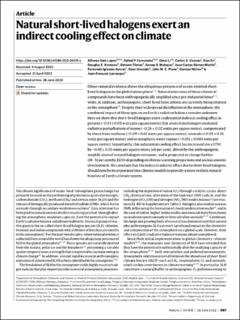| dc.contributor.author | Saiz-Lopez, Alfonso | |
| dc.contributor.author | Fernandez, Rafael P. | |
| dc.contributor.author | Li, Qinyi | |
| dc.contributor.author | Cuevas, Carlos A. | |
| dc.contributor.author | Fu, Xiao | |
| dc.contributor.author | Kinnison, Douglas E. | |
| dc.contributor.author | Tilmes, Simone | |
| dc.contributor.author | Mahajan, Anoop S. | |
| dc.contributor.author | Gómez Martín, Juan Carlos | |
| dc.contributor.author | Iglesias-Suarez, Fernando | |
| dc.contributor.author | Hossaini, Ryan | |
| dc.contributor.author | Plane, John M. C. | |
| dc.contributor.author | Myhre, Gunnar | |
| dc.contributor.author | Lamarque, Jean-François | |
| dc.date.accessioned | 2024-03-04T14:28:37Z | |
| dc.date.available | 2024-03-04T14:28:37Z | |
| dc.date.created | 2023-08-25T14:16:07Z | |
| dc.date.issued | 2023 | |
| dc.identifier.citation | Nature. 2023, 618 (7967), 967-973. | en_US |
| dc.identifier.issn | 0028-0836 | |
| dc.identifier.uri | https://hdl.handle.net/11250/3120938 | |
| dc.description.abstract | Observational evidence shows the ubiquitous presence of ocean-emitted short-lived halogens in the global atmosphere1,2,3. Natural emissions of these chemical compounds have been anthropogenically amplified since pre-industrial times4,5,6, while, in addition, anthropogenic short-lived halocarbons are currently being emitted to the atmosphere7,8. Despite their widespread distribution in the atmosphere, the combined impact of these species on Earth’s radiative balance remains unknown. Here we show that short-lived halogens exert a substantial indirect cooling effect at present (−0.13 ± 0.03 watts per square metre) that arises from halogen-mediated radiative perturbations of ozone (−0.24 ± 0.02 watts per square metre), compensated by those from methane (+0.09 ± 0.01 watts per square metre), aerosols (+0.03 ± 0.01 watts per square metre) and stratospheric water vapour (+0.011 ± 0.001 watts per square metre). Importantly, this substantial cooling effect has increased since 1750 by −0.05 ± 0.03 watts per square metre (61 per cent), driven by the anthropogenic amplification of natural halogen emissions, and is projected to change further (18–31 per cent by 2100) depending on climate warming projections and socioeconomic development. We conclude that the indirect radiative effect due to short-lived halogens should now be incorporated into climate models to provide a more realistic natural baseline of Earth’s climate system. | en_US |
| dc.language.iso | eng | en_US |
| dc.publisher | Springer Nature ltd | en_US |
| dc.rights | Navngivelse 4.0 Internasjonal | * |
| dc.rights.uri | http://creativecommons.org/licenses/by/4.0/deed.no | * |
| dc.title | Natural short-lived halogens exert an indirect cooling effect on climate | en_US |
| dc.title.alternative | Natural short-lived halogens exert an indirect cooling effect on climate | en_US |
| dc.type | Peer reviewed | en_US |
| dc.type | Journal article | en_US |
| dc.description.version | publishedVersion | en_US |
| dc.source.pagenumber | 967-973 | en_US |
| dc.source.volume | 618 | en_US |
| dc.source.journal | Nature | en_US |
| dc.source.issue | 7967 | en_US |
| dc.identifier.doi | 10.1038/s41586-023-06119-z | |
| dc.identifier.cristin | 2169737 | |
| cristin.ispublished | true | |
| cristin.fulltext | original | |
| cristin.qualitycode | 2 | |

